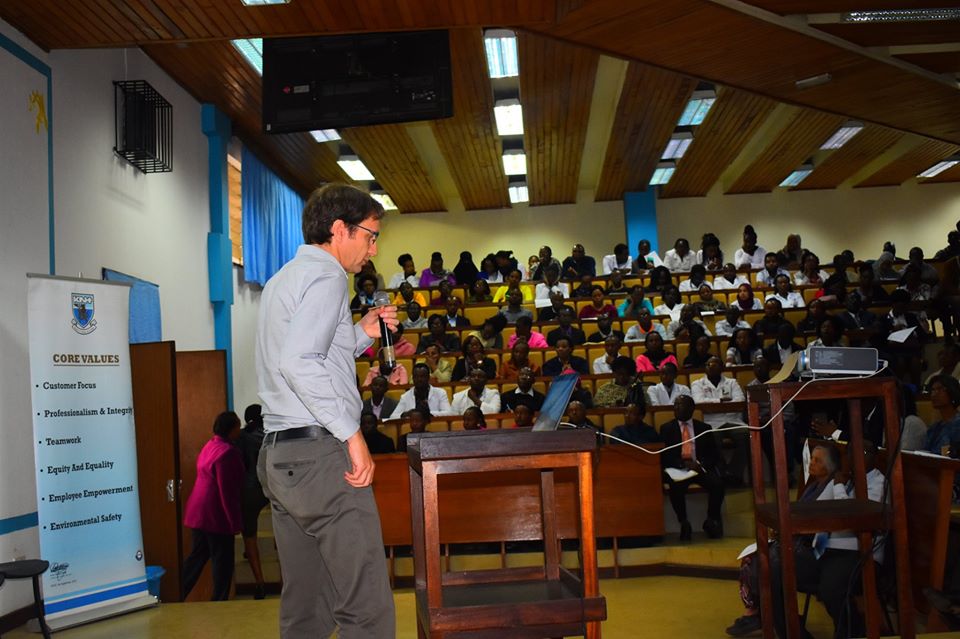
Currently in Kenya, the burden of cancer is estimated at 47,887 new cases and 32,978 deaths annually. It is further estimated that there are 3,200 new cases of cancer annually among children below 18 years. The top 5 most common cancers in Kenya include breast, cervical, oesophagael (alimentary canal), prostate and colorectal cancers.Cervical cancer is rated the second most frequent cancer among women in Kenya with 4802 new cases diagnosed every year. These were the statistics shared during the KNH-UoN symposium titled “Cervical Cancer Elimination is Feasible: Update on HPV Vaccine” that was held today at Lecture Theatre III UoN campus from 8.00 am to 10.30 am.
Cervical cancer is the number one killer cancer among women in Kenya though it is 100% preventable. The research findings presented during the symposium indicate that human papilloma virus (HPV) is the cause for cervical cancer. While presenting on the options towards preventing cervical cancer, Dr. Innocent Maranga, who is a former HOD Gynaecology & Obstetrics at KNH and renowned gynaecologist and obstetrician, mentioned that cervical cancer is 100% preventable and curable at the primary, secondary and tertiary level. Other than abstinence, use of condoms and administration of the HPV vaccine are primary means to prevent cervical cancer.
Despite there being a safe and effective vaccine that could greatly reduce the risk of cervical cancer, there are several challenges in implementation of the vaccine tool. Dr. Peter Dull, the Deputy Director for Integrated Clinical Vaccine Development-Global Health Division at Bill and Melinda Gates Foundation, highlighted that vaccine cost, delivery cost, delivery complexity and supply challenges remain significant in preventing HPV vaccine progress.
In addition, there is a lot of vaccine hesitancy among members of the society. Vaccine hesitancy is “delay in acceptance or refusal of vaccines despite availability of vaccination services” (WHO). According to Dr. Gaudensia Mutua, compulsory vaccination and confidence building through dialogue will go a long way in reducing HPV vaccine hesitancy.
The Symposium was concluded with an interactive Q & A session that brought out issues on the HPV vaccine supply in Kenya, the comprehensiveness of the services offered on sexual and reproductive health by the Ministry of Health and the age limit viable for the HPV vaccine. The HPV vaccine is available in Kenyatta National Hospital at Kshs. 2000.
Multidisciplinary clubfoot clinic-46 gets a facelift at KNH
KNH Orthopedic Multidisciplinary Clubfoot Clinic (Orthopedic Technology department) received 40 pairs of corrective brace and 40 pairs of special socks as donation from a well-wisher on 25th July, 2019.
These devices are used to manage and treat clubfoot in children. Clubfoot is a birth defect in which a baby’s foot is twisted out of shape or position. It could affect one or both feet and can be mild or severe. If left untreated, it leads to serious problems like arthritis, inability to walk normally and poor self-image because of the crooked appearance of the feet among others. Early intervention is therefore highly recommended.
“The defect is corrected without surgery with casting followed by the use of Ponseti AFO Brace to avoid relapse,” said Mr. John Ondiege, H.O.D. Orthopedic Technology. “The child will then use the brace for a period of 3 years within which the defect on the foot will have been corrected,” added Mr Ondiege.
Speaking while receiving the donation, Mr.Emmanuel Mayakah, the coordinator of the Clubfoot Clinic said that the new braces will improve clinical outcome since it is the design which is globally accepted. Patients in Kenya will not need to seek clubfoot treatment abroad.
The Orthopedic Technology department will start a brace exchange program with this donation where braces can be exchanged for a fitting pair once a patient outgrows them.
The multidisciplinary clubfoot clinic at KNH was launched in 2008 and has successfully treated over 2000 babies with clubfoot.
